| Photopia Sportsman Cameras |
|
|
|
|
The illustration below is page 7 of the Photopia International Limited catalogue for 1981/82. At the time this catalogue was current, the Photopia Group consisted of several marketing companies and the page shown is advertising cameras sold under Paul Plus Limited's own 'Plus' brand. It is noticeable that 3 ILFORD camera names are in use on this page, Sportsman, Sportsmaster and Sporti. I understand that Charles Strasser, of Photopia, used the Sportsman names with Ilford's agreement, since these camera names had been 'dropped' by Ilford 15 years previously. Some, at least, of these cameras were made in Singapore (see Sporti 2000 and Plus Sporti, near the bottom of this page). |
|
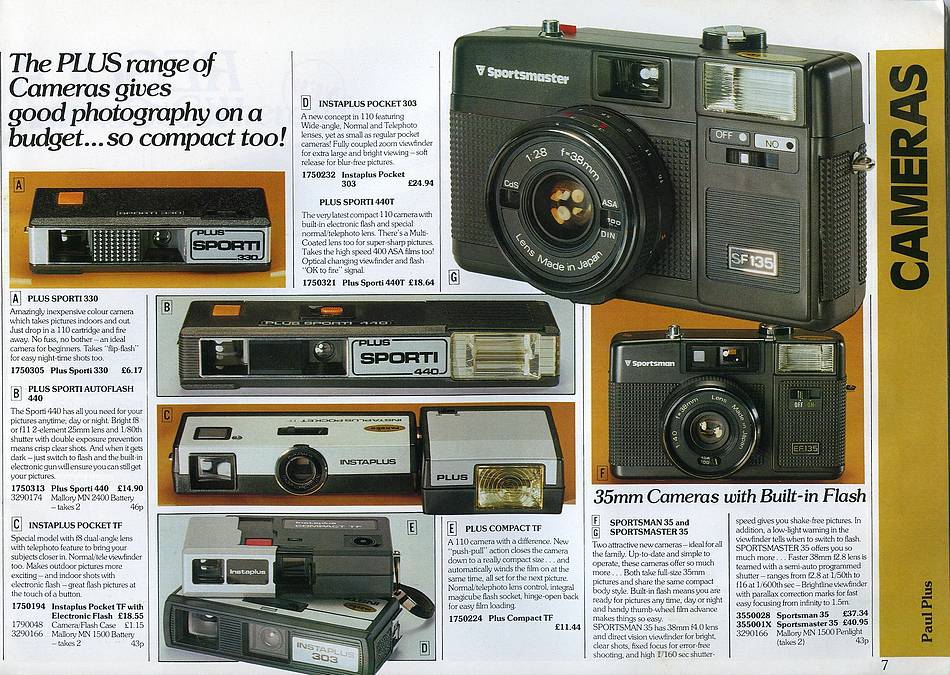 |
|
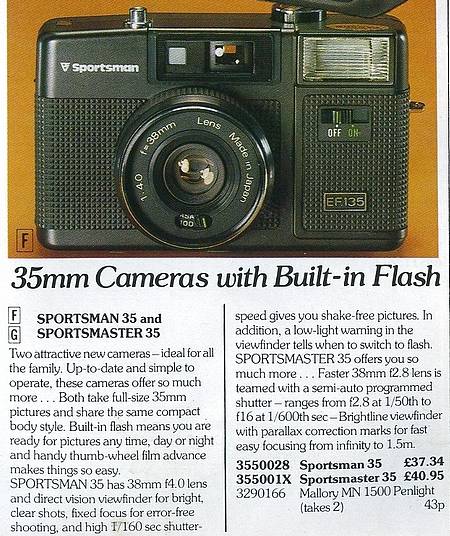 |
The Sportsman EF135 and Sportsmaster SF135, were both made in Japan (not by the W.German company, Dacora). The Sportsmaster had the faster f2.8 lens (instead of a f4), a semi-auto programmed shutter (instead of a single fixed 1/160th sec) and a parallax compensated bright-line viewfinder. The Sportsmaster also had focussing from infinity to 1.5m (instead of fixed focus). Prices were remarkably similar and it would seem obvious that the Sportsmaster offered better value. But the simpler Sportsman might have appealed to novices wanting a simpler 'point & shoot' camera. 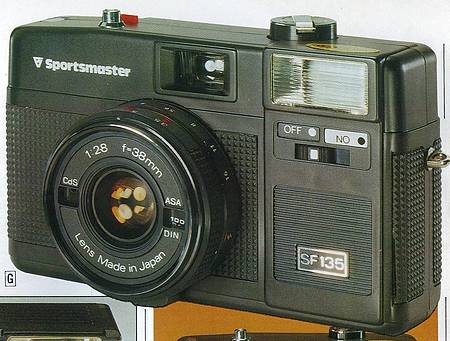 |
|
The Plus Sporti range of cameras, unlike the roll film Sporti marketed by Ilford 20 years previously, took 110 cartridge film, as introduced by Kodak in 1972 producing negatives 13×17 mm. There were 3 Sporti cameras in the Plus range, a basic 330, a 440 with built-in electronic flash and a 440T with flash and 'normal/telephoto' lens changeover facility. 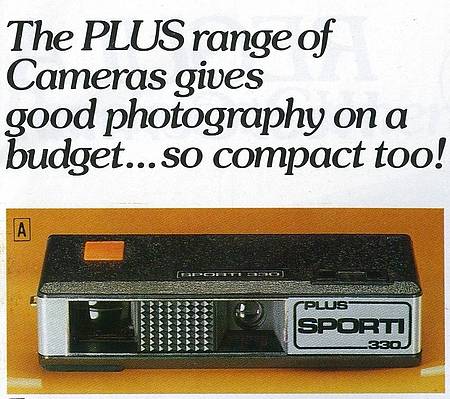 |
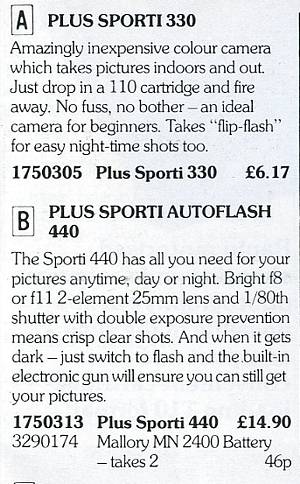 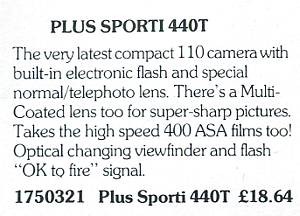 |
 |
|
|
The Plus Sporti 440T seemingly became known as the Sporti 2000, as a camera of the identical description and near identical appearance as the 440T, with its box bearing the same Paul Plus identication No.1750321, was found at the Wolverhampton Camera Fair on December 7th 2008. It is now called a 'Pocket Teleflash Camera'. Packed in a smart blue base, clear flip top, plastic case, with a detachable lanyard and instructions. |
||
|
Featuring a "Super-sharp multi-coated 20mm lens for colourful scenic or group pictures (f6.5 to f11, 3 elements) and a built-in 40mm multi-coated tele lens (f9.5, 2 elements) for large as life portraits and close-ups. Optics in viewfinder automatically change for normal or tele shots. Shutter speed 1/100th sec, metal blade, mechanical with double exposure prevention. Takes standard 110 film cartridges for easy drop-in loading; accepts standard film or fast film for dull days. Built-in electronic flash for use indoors - no expensive flash-bulbs needed". Flash range 1.5 to 3m with 100ASA film, 1.5 to 4.5m with 400ASA film. The flash requires two AA size battery cells.
|
||
|
|
|
| Another Plus
Sporti camera taking 110 film cartridges, is owned by Gavin
Ritchie, who has sent the following pictures. It has no number
attaching, unlike the Plus Sporti 330, 440, 440T and 2000 versions
shown above. It was made in Singapore and says on it "Made under Eastman Kodak Licence". It has its original box which says "Pocket Sized Camera for Instant Load film with flashcube extender - Made in Singapore 1750151". |
|
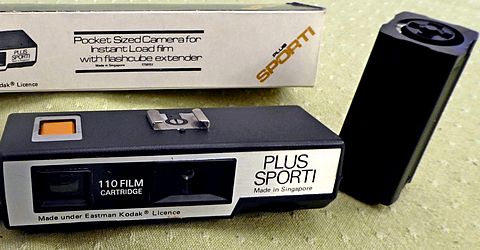 The flash cube extender (separate from the camera, above, and inserted into the hot shoe in the picture right) was supplied with the camera. Its purpose was to raise the level of the flash sufficiently from the lens, to avoid 'red eye' reflections. |
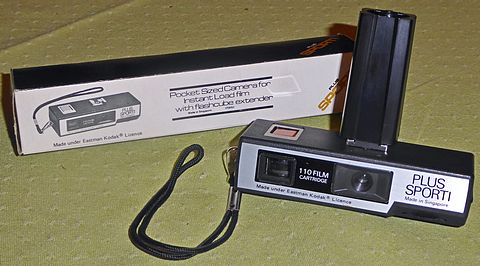 |
| Sportsmaster Exposure Meter | |
|
Another Wolverhampton Camera Fair 'find' on Sunday 24th April 2016. In the same colour striped box as Sporti 200 camera, above, this is a simple selenium cell exposure meter. Named as the 110S, there were two others in the range, both being cadmium sulphide cell types, the 120 CdS and the 130 CdS, the latter having an incident light measuring facility. It was supplied complete with a black plastic zip-around case and lanyard. Complete in its box it cost £11.95p in August 1982. The one shown here was supplied by J. McNeil (Cameras) Ltd of Oxford. |
|
|
|
|
|
|
The meter was pointed toward the subject to be photographed. The pointer then indicated a light intensity number (7 in the illustration, left). The outer dial was then turned until the white index mark on the outer rim of the black central wheel appeared against the same number as on the lighting scale. It was then only necessary to select a shutter speed and f/stop combination from the shutter speed scale and f/stop scale, respectively. It could also be used for cine work and with shutters that had the EV (Exposure Value) light intensity numbering system. There is no mention of Photopia, or its subsidiary Paul Plus, on the packaging, but maybe the symbol on the box lid, before the word Sportsmaster, is a logo for PI = Photopia International. |
| Sportslite Slave (flash) Unit | |
|
Drawing upon the name of the Ilford Sportslite flashgun from 1959, the Photopia International 'Slave Unit' triggered a second flash gun by sensing the light from the primary flash fired from the camera. This small (2.5cm x 2.5cm x 1.5cm) solid state device needed no batteries to trigger the second gun, but of course the 2nd gun required its own power supply (batteries) to provide a flash. Picture and original instructions are shown below. |
|
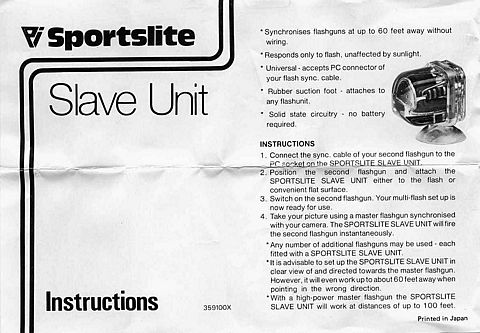 * Synchronises flashguns at up to 60 feet away without wiring. * Any number of additional flashguns may be used - each
fitted with a SPORTSLITE SLAVE UNIT. |
|
|
|
|
|
|
|